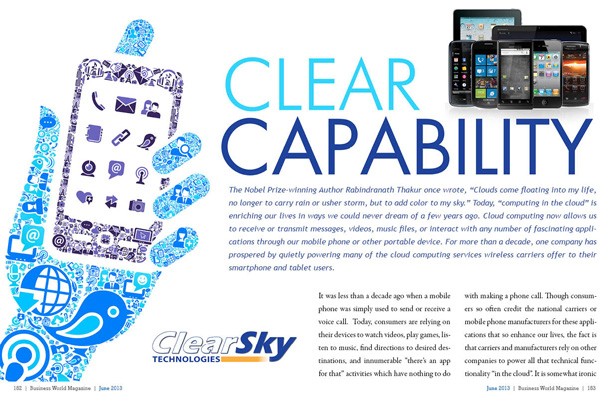
Clear Capability

The Nobel Prize-winning Author Rabindranath Thakur once wrote, “Clouds come floating into my life, no longer to carry rain or usher storm, but to add color to my sky.†Today, “computing in the cloud†is enriching our lives in ways we could never dream of a few years ago. Cloud computing now allows us to receive or transmit messages, videos, music files, or interact with any number of fascinating applications through our mobile phone or other portable device. For more than a decade, one company has prospered by quietly powering many of the cloud computing services wireless carriers offer to their smartphone and tablet users.Â
It was less than a decade ago when a mobile phone was simply used to send or receive a voice call. Today, consumers are relying on their devices to watch videos, play games, listen to music, find directions to desired destinations, and innumerable â€there’s an app for that†activities which have nothing to do with making a phone call. Though consumers so often credit the national carriers or mobile phone manufacturers for these applications that so enhance our lives, the fact is that carriers and manufacturers rely on other companies to power all that technical functionality “in the cloudâ€. It is somewhat ironic that a company named ClearSky Technologies, based in Orlando, Florida, provides many of these “cloud computing†services to the wireless industry.
ClearSky has been an industry-leading innovator of services that add functionality, increase coverage, and enhance capacity for over a decade. Today, ClearSky services more than 60 wireless operators throughout North and South America. From interactive messaging platforms for SMS and MMS to a first-of-its-kind small cell gateway, ClearSky’s services have allowed regional wireless carriers to stay competitive, and for national carriers, it is quickly deploying targeted solutions to service specific target markets.
Pioneering Professionals
Text messaging and mobile Internet access has become such a common capability that it seems increasingly difficult to consider how the world could have ever functioned before these services came into existence. Â ClearSky founders Bill Poellmitz and Dean Fresonke were among the experts who helped usher in a new era of wireless data communications. Throughout the 1980s and early 1990s, Poellmitz was a director for three different cellular telephone companies operating in the Caribbean and also travelled extensively, developing distribution channels for high-tech products in Latin America and China. Â During this same era, Fresonke worked in research and development for AT&T Bell Laboratories. Fresonke was among the team working on the first computer chips for Global System for Mobile Communications (GSM), the European standard for digital mobile phones that went on to become the world standard. Seeing a trend on the horizon, Fresonke left AT&T to launch a consulting company called Data on Air.
“We didn’t have consumer-friendly handsets back then,†says Fresonke. Instead, the focus in the late 1990’s was on industrial applications. Among the earliest products that Data on Air sold was a shoebox-sized contraption that allowed for vehicle tracking. The device enabled utilities, transportation companies, and other industries to effectively monitor fleet operations. Vehicles could be readily located through an interface between the vehicle and its headquarters facilitated by an early generation cloud-based network.  Meanwhile, Poellmitz had gone on to found a company known as Cerulean, an enterprise that pioneered mobile computing in law enforcement. Cerulean was the leader in equipping police cars with a laptop computer wirelessly connected to their respective state databases, allowing law enforcement to rapidly access warrant information or criminal background on a vehicle operator during traffic stops. It was a breakthrough that has become so valuable virtually no law enforcement agency can function without it today. Poellmitz ultimately sold his interest in Cerulean and went on to join forces with Fresonke at Data on Air just in time to help shepherd the sale of the company to a San Francisco-based dotcom during the Internet boom in the year 2000.
The dotcom crash that followed shortly thereafter saw investors running for the hills as their companies crashed in the ditch. Â With the new parent in deep trouble, Fresonke and Poellmitz acquired many of the cloud computing assets of the original Data on Air and retooled them into the foundation on which ClearSky Technologies was created. Â The new company was making significant advances when the New York terror attacks of September 11, 2001, prompted not only the crash of the World Trade Center towers, but also turmoil for many unrelated industries. As Fresonke recalls, during the first two years that followed the tragedy, investment in telecomm and wireless came to a grinding halt. During this ensuing period of declining business in the U.S., ClearSky was able to capitalize on inroads that Poellmitz had made in Latin America, and the company went on to become a leading provider of hosted data services, running mobile browsing and messaging applications for carriers in locations as widespread as Mexico, Colombia, Venezuela, Peru, Chile, and Uruguay.
After five-plus years of success in the South American market, the piper that led the company back to the U.S. didn’t play a flute; it instead was a cell phone playing a ringtone.  Fresonke says it wasn’t until 2006 that U.S. consumers really began to wake up to the power that was in their hands. Though business operations had been relying on ClearSky’s array of services, consumers were still using their cell phones for voice calls. Then along came the ringtone. Something as simple as playing a favorite song when the phone rang drove consumers to begin using their handsets to access the wireless data network to download a tone. As Fresonke explains, “Even in the mid 2000’s the phones and networks were capable of some pretty sophisticated Web interactions but it was ringtones that got many people started… we, who were supposedly the industry experts, never would have guessed that the musical tail that would wag the data dog… and once it got started people demanded more.†To deliver the musical magic, ClearSky built ringtone content servers, cut deals with all the major record labels, and connected into carrier billing systems so consumers could buy with a single click. Ringtones could now be delivered from the ClearSky cloud and dozens and dozens of carriers were able to quickly and easily get into the ringtone business.
As the array of services that a phone could deliver continued to grow, ClearSky expanded the array of available cloud services, building and operating the infrastructure that powers all that technical capability consumers have come to expect. Specialized services such as text messaging and picture messaging were added to the suite of services with the help of industry-leading software partners such as Jinny Software out of Dublin, Ireland. In this case, Jinny’s specialized software was combined with ClearSky’s cloud infrastructure and delivery mechanisms. “Our entire business is driven by making sure the computing platforms that are necessary for delivering value-added services and wireless network enhancements are available for rapid deployment at cost effective prices. We partner with world class software and infrastructure companies and together we develop these cutting edge cloud services,†says Fresonke. With three data centers currently operating in the U.S., ClearSky has invested in the computing equipment and technical resources that eliminate the need for wireless carriers to invest in this same equipment and software and then hire and train the people needed to operate it. “Carriers can invest in differentiating themselves in the market, while we take care of adding essential capabilities to the devices,†says Fresonke.
Careful What You Wish For
The proficiency of the wireless industry in bringing such a wide range of interesting services to mobile devices has created the next set of problems the industry needs to solve; namely growing network capacity, expanding coverage and increasing data transmission speeds. The exploding use of the wireless for data and voice is now overloading carrier networks and the load is increasing with every person walking out of a store with their new smartphone or tablet. The habits of using mobile data have become so ingrained in our lifestyles that consumers demand their new devices to work perfectly not only out on the street, but deep inside a department store or on the shores of a remote beach. Network coverage and capacity for high speed communications has transformed from a ‘nice-to-have’ to a ‘must-have’.
Traffic Management Marvel
As Fresonke explains, data-hungry, Internet-based mobile services dominate today’s smartphone-centric world. For example, Web video services such as “YouTube†and “Netflix†can comprise 50 percent of all mobile data traffic on a given weekend night. The higher demand on mobile networks equates to more subscribers sharing a limited slice of wireless spectrum. A few heavy data users on a cellular tower can make it miserable for all the other users attempting to use the network via that same tower. The woman struggling to get a connection to check movie times couldn’t care less that the guy in the apartment next door is watching flawless video. This is an example of ‘fair use’ of a network. Carriers need to give all their customers a good experience, balancing out their finite capacity. But to do this, it takes a tremendous amount real time computing horsepower and sophisticated software algorithms to analyze what every customer is doing at every moment, and not that many carriers have the wherewithal to deploy such a system. Cloud delivery once again becomes the solution.  ClearSky came to market with a comprehensive traffic management and policy enforcement “platform in the cloud†that can not only enforce fair usage, but also provide many new ways to bill for usage in a fair and equitable way.
ClearSky calls their solution Total Traffic Manager, or TTM for short.  TTM monitors and analyzes data traffic in real time as it flows through a carrier’s network. It provides real-time traffic visibility and generates actions based on a pre-configured set of rules and policies. With insight as to why, and how, traffic is impacting the performance of their network, a carrier can enact and enforce network policies, satisfy subscribers with fair allocation of resources, and ensure traffic flow continues unaffected–even if capacity is at its limit. Even though much of the service is in the cloud, ClearSky can actually tailor TTM to fulfill the specific policy requirements of each and every carrier.
Big Problems Solved with Small Cells
The wireless industry is tackling many of its coverage and capacity issues by adding small cells to the networks. Small cells are miniature cell sites that divide and reuse the same wireless spectrum over and over. Adding small cells improves signal strength and can bring coverage into homes, offices, stores and public spaces where traditional outdoor towers are unable to reach. However, small cells require a complex arrangement to connect back into a wireless carrier’s switching center because they are so numerous and use the public Internet. ClearSky is the first company in North America to use cloud computing to offer a rapid small cell deployment option called Femtocell as a Service (FaaS). To explain this, Fresonke says that a femtocell is a type of small cell, about the size of a dinner plate, which can be easily placed in a home or mounted in a commercial building. Once powered up and connected to the Internet, it connects to the ClearSky FaaS cloud, analyzes its surroundings, configures itself, and begins providing voice and data services for nearby subscribers. Anywhere users encounter trouble accessing cellular service, a femtocell can usually be deployed to correct the problem.
The benefits of working with ClearSky were recently articulated by the CEO of Cellular One of East Central Illinois, Cassy Carter, who said, “ClearSky’s FaaS meets our need to deliver high-quality voice and data coverage, and does so at a fraction of the cost of expanding our macro network… or purchasing a Femtocell Gateway of our own. One of our primary objectives is to reduce churn by improving in-home coverage for subscribers on the periphery of our macro cellular network, and residential Femtocell Access Points are ideal for that purpose.â€
4G for Everyone
4G (or 4th generation) wireless networks are the wireless industry’s latest technological achievement. By transmitting data many times faster than the 3G networks they are replacing, 4G networks help with the data crunch by literally creating more capacity out of thin air. To achieve this, the entire wireless industry had to toss away the old ways of sending information over the air and replaced it with a new standard called Long Term Evolution or LTE. LTE has required everyone from the infrastructure manufacturers to the companies that build the chips inside handsets to go back to the drawing boards. LTE has proven it can deliver the additional capacity and speeds the industry was hoping for but the price is high. Because LTE is all new, it requires almost every component of a wireless network to be changed out.
The cost to upgrade to LTE can be dramatic for small wireless carriers.  The equipment at the core of the network can cost millions and requires a completely different employee skill set as compared to the 2G and 3G networks it replaces. Seeing the need, ClearSky made the investment in an LTE core network and put it into their cloud. ClearSky’s LTE Services Suite now enables small carriers to vastly decrease the investment they need to make to build and operate a new LTE network.  In the ClearSky model, carriers only need to invest in the tower equipment. The rest of the LTE network runs in a private, secure cloud.
Clear Sailing in the Cloud
Like the fluffy examples in a summer sky, clouds are an ever present but seldom noticed part of our everyday lives. In a similar way, cloud computing brings a multitude of features and functionality to our favorite mobile devices without us ever having to contemplate the technical heavy lifting that makes it all possible. Hidden within these complex clouds, ClearSky continues to help evolve and operate the ever changing wireless networks consumers have become so reliant upon, invisible to everyone except the wireless industry insiders. “We are very content to be invisible to consumers, making their mobile life better without them ever knowing it,†states Fresonke.
Perhaps ClearSky is not such an ironic name after all.
For more information, please visit their website at: Â ClearSky Technologies
Preferred Vendor of Choice:








As soon as I found this web site I went on reddit to share some of the love with them.
Comments are closed.